Different types of motion sensors are commonly used in security systems. They work based on a wide variety of principles and are used in a wide variety of applications. Typical usage could be in the exterior doorways or windows of a building for monitoring the area around the building. Upon detecting motion, they generate an electrical signal based on which some actions are taken.
Some operate in much the same way as a military radar scanner, while others work based on vibration, infrared radiation and, even sound. All of these different types of sensors have different strengths and weaknesses, which are important to take into account when making a decision to choose a particle motion detection sensor.
Types of Motion Sensors
Motion sensors are classified based on how they detect the motion of a body. The two classifications are listed below with a brief explanation of their operation
Active Detectors
Active Detectors are also known as Radar-based motion sensors. The active detector sensors emit the radio waves/ microwaves across a room or other place, which strike on nearby objects and reflect it back to the sensor detector.
When an object moves in a motion sensor-controlled area at this time, the sensor looks for a Doppler (frequency) shift in the wave when it returns to the sensor detector, which would indicate that the wave has hit a moving object. The Motion sensor is able to understand these changes and send an electrical signal to the alarm system, light, or other types of device that is connected to the motion sensor.
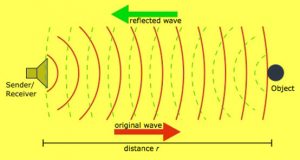
Active Motion Sensor Operation.
When an object moves in a motion sensor-controlled area at this time, the sensor looks for a Doppler (frequency) shift in the wave when it returns to the sensor detector, which would indicate that the wave has hit a moving object.
The Motion sensor is able to understand these changes and send an electrical signal to the alarm system, light, or other types of device that is connected to the motion sensor.
Active sensors that use microwaves for movement detection are mostly used in such applications as automatic doors in shopping malls and similar applications, but can also be found in house security alarm systems and are used for indoor lighting systems.
Active motion sensors are not best suitable for outdoor lighting or similar applications as a movement of random objects such as windblown things, smaller animals and, even larger insects can be detected by the active sensor and lightning will be triggered.
Passive Detectors
Passive Motion Sensors are opposite to active sensors, they do not send out anything, but it simply detects the infrared energy. Infrared (heat) energy levels are sensed by passive detectors. Passive sensors scan the room or area, it is installed for infrared heat that is radiated from living beings.
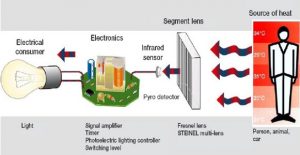
Passive Motion Sensor Operation
Actually, heat is radiated from any object with a temperature above absolute zero. When an object walks into the detection area of a passive sensor, it detects heat emitted from that object and activates the alarm or turns on the light or any application.
These sensors would not be effective if they could get activated by a small animal or insect that moves in the detection range, however, most passive sensors can be adjusted to pick up the motion of an object with a certain level of emitted heat, for example adjusting the sensor to pick up movement only by humans.
Combined (Hybrid) Sensors
A combined or Hybrid technology motion sensor is a combination of both active and passive sensors. It activates light or alarm only in such a case when motion is detected by both active and passive sensors. Combined sensors are useful for alarm systems to reduce the possibility of false alarm triggers.
However, this technology also has its disadvantages. It cannot provide the same level of safety as separate PIR and microwave sensors because the alarm is triggered only when motion is detected by both sensors.
So for example, if a burglar knows how to escape one of the sensors, his movement is going to be detected just by one sensor, but not by another sensor, at that time no signal will be sent to the alarm system and it won’t be turned on. The most popular type of dual technology sensors combines a PIR and a microwave sensor.
So for example, if a burglar knows how to escape one of the sensors, his movement is going to be detected just by one sensor, but not by another sensor, at that time no signal will be sent to the alarm system and it won’t be turned on. The most popular type of dual technology sensor combines a PIR and a microwave sensor.
However, this technology also has its disadvantages. It cannot provide the same level of safety as separate PIR and microwave sensors because the alarm is triggered only when motion is detected by both sensors.
So for example, if a burglar knows how to escape one of the sensors, his movement is going to be detected just by one sensor, but not by another sensor, at that time no signal will be sent to the alarm system and it won’t be turned on. The most popular type of dual technology sensor combines a PIR and a microwave sensor.
The motion sensors come in different shapes and sizes. Here we are explaining below a couple of examples
Passive Infrared Detectors (PIR)
These are some of the widely used sensors nowadays and can be found in many home security systems. Passive Infrared Detectors are looking at the changes in infrared energy level that are caused by the movement of objects (humans, pets… etc.).
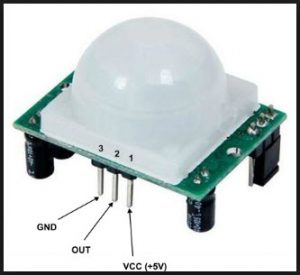
Passive Infrared Detectors (PIR)
PIR Motion detector is very easily obstructed by the variability of heat sources and sunlight, so the PIR Motion detector is more suitable for indoor movement detection within the closed environment.
Active Infrared Sensors
Designed to emit an electrical signal that connects to a light detector. As soon as the beam gets interrupted, it may sound the motion sensor alarm.
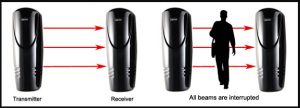
Active Infrared Sensor
Active infrared Detectors use a dual-beam transmission as a structure, one side of a transmitter for emitting Infrared Ray, and the other side with a receiver for receiving the IR, it is suitable for the outdoor point-to-point interruption detection.
Active Infra-Red Beam motion sensors are mainly installed outside, due to it adopts transmitter and receiver theory for detection. It is important that the beam must go through the detection area and reach the receiver.
Ultrasonic Detector
These types of motion sensors are available in both active and passive. In theory, an ultrasonic detector sends out high-frequency sound waves that are reflected back to the sensor. If any interruption occurs in the sound waves, the active ultrasonic sensor may sound the alarm.
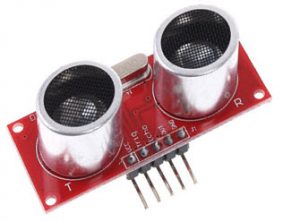
Mini Ultrasonic Motion Detector
Applications of Types of Motion Sensors
Some of the key applications of motion detectors include:
- Intruder alarms
- Automatic ticket gates
- Entryway lighting
- Security lighting
- Hand dryers
- Automatic doors
- Ultrasonic sensors are used for triggering the security camera at home and for wildlife photography.
- Active infrared sensors used To indicate the presence of products on conveyor belts
Here some of the practical applications of both the active and passive motion detector sensors are given below.
Liquid Level Controller using Ultrasonic Sensors
The below figure shows how Liquid Level Controller using Ultrasonic Sensor works for controlling the liquid levels in a tank by operating a motor by sensing predefined limits of the liquid.
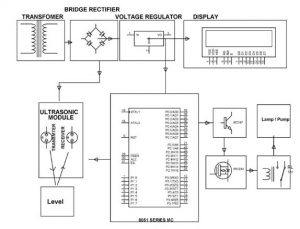
Liquid Level Controller using Ultrasonic Sensors by
When the liquid in the tank reaches lower and upper limits, then the ultrasonic sensor detects these limits and sends the signals to the Microcontroller. The Microcontroller is programmed in such a way that it operates a relay for driving the motor pump based on the limit condition signals from the ultrasonic sensor.
Please refer to this link to know more about Sensors MCQs
Automatic Door Opening System Using PIR sensor
Similar to the above system, the Automatic Door Opening System using a PIR sensor detects the presence of humans to perform door operations, i.e., opening and closing the door. As we have discussed above, a PIR sensor detects the presence of humans alone and enables the Microcontroller pins when motion is detected. Depending on the signals from the PIR sensor, the Microcontroller operates the door by operating the motor in forward and reverse rotation modes with the help of a driver IC.
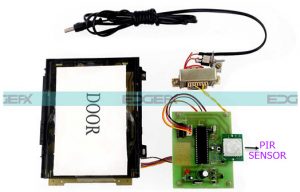
Automatic Door Opening System Using PIR sensor
This is a brief description regarding the types of motion sensors and their applications with some practical examples of motion detectors. If you still intend to know more regarding these motion sensors or any other sensor-based projects you can post your queries by commenting below.
Please refer to this link to know more about Sensors MCQs & Face Recognition MCQs.
Please refer to this link to know more about IR Sensor & Alcohol Detection System.